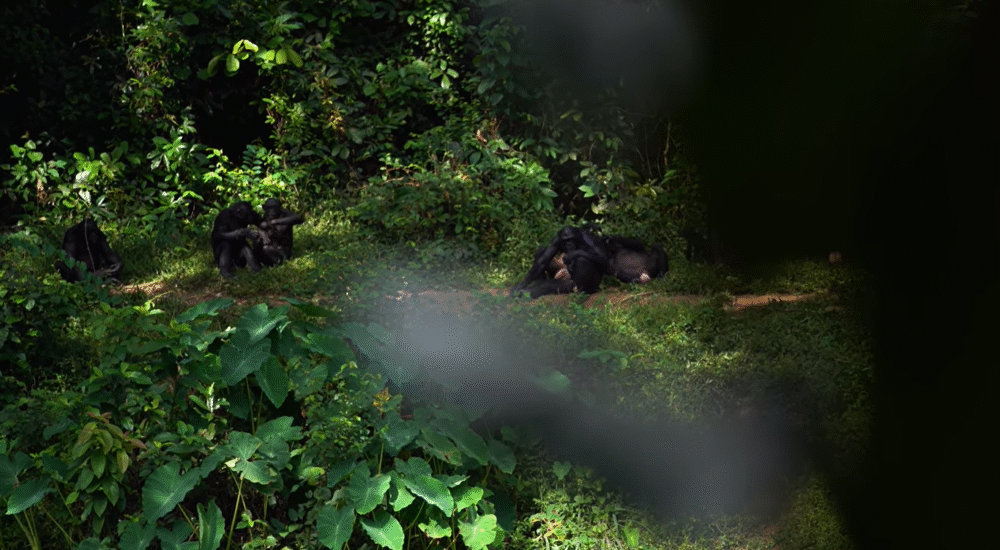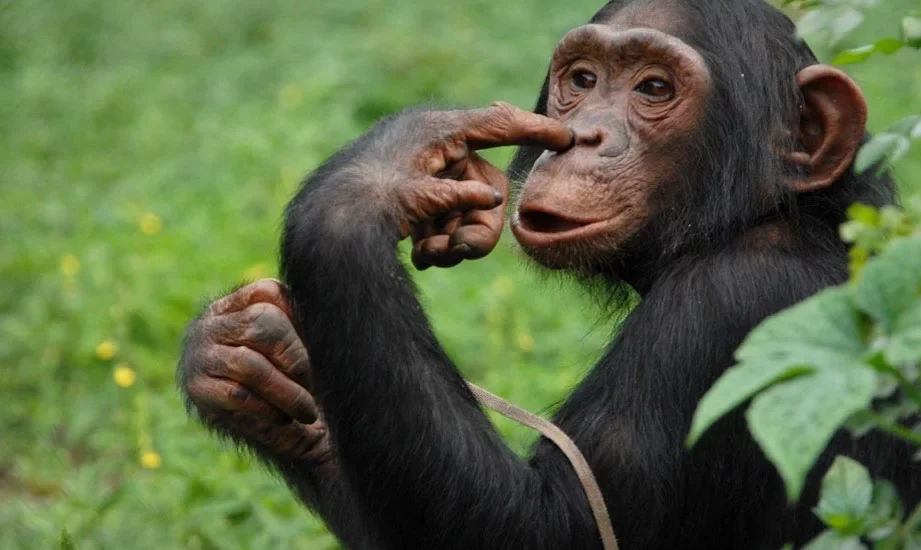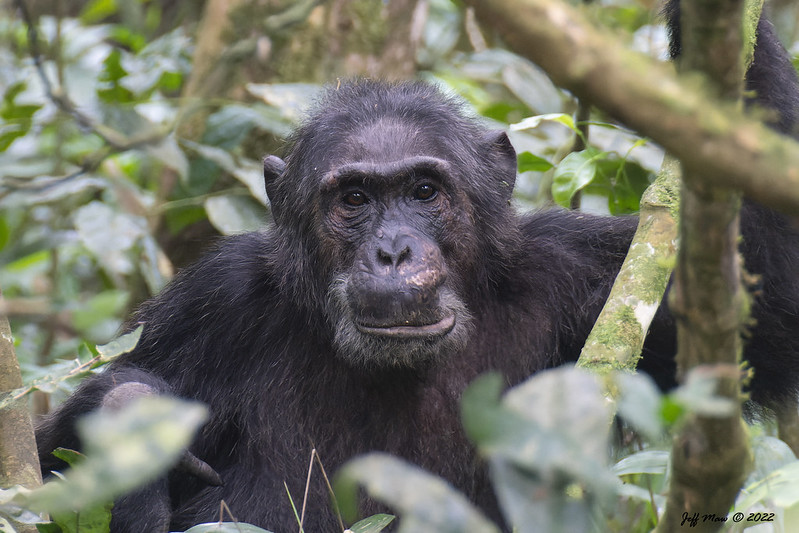Chimpanzee tracking in Kibale National Park offers one of the most immersive wildlife experiences in…
Facts About Chimpanzees
Facts About Chimpanzees, Chimpanzees are big apes and are in the same family as humans, Hominidae. Chimpanzees, which live in western and central Africa, are the closest living cousins of humans. About 98% of our DNA is the same as theirs. Chimpanzees are also in danger because their numbers are going down.
People and chimps alike laugh together, make friends, and use tools to get what they want. Born in the wild, chimps live for about 50 years. When kept as pets, they can live up to 60 years. Children develop strong bonds with their mothers and stay close to them for the rest of their lives. These social primates live in treetops and walk on all fours.
We are still learning new things about them after decades of study. Find out the most interesting things about chimpanzees, like how they keep their nests very clean and how their personalities stay the same over time.
Chimpanzees live in the grasslands and tropical jungles of Africa. They are great apes and naturally beautiful animals. You can also call them chimps, and there are four known types. Chimpanzees and bonobos are both in the genus pan, which scientists found by comparing fossils. Because they share 75% to 95% of our DNA, these wild animals are thought to be related to humans. The rough black hair, bare lips, and figure-toed, palm- and sole-shaped feet of chimpanzees make them easy to spot.
Compared to bonobos, they are bigger and stronger. Males weigh 40 to 70 kg, while females weigh 27 to 50 kg. Chimpanzees in the wild live about 25 years, with males living 31.7 years and females 38.7 years.
Facts About Chimpanzees
They are in danger
Chimpanzees are our closest living cousins, but their numbers are falling and they are in danger of going extinct. The biggest problems for chimps are being poached, getting diseases, losing their habitat, and having the quality of their environment go down because of people using it for other things. It is against the law to catch, kill, or eat chimpanzees, but hunting is the biggest threat to their survival.
Even though they are legally protected in their area, enforcement is weak, and chimp populations need stricter protection from the law. Chimpanzees need better coordinated land use control in their range to protect them from more habitat loss caused by farming projects. This will also increase their chances of survival. Another big risk for chimps is that they can get diseases that people can get because they are so similar. Chimpanzees can get diseases when they come into contact with people, whether they are tourists or researchers.
How Much Do Chimpanzee Trekking Permits in Uganda Cost?
They clean their homes and nests just like people do.
Did you know that chimp houses are cleaner than beds? As per a study from Tanzania, chimp nests are not as likely as human beds to have germs from feces, skin, or mouth. They do this because every night they build a new nest, which keeps germs from building up. Researchers also said that out of the 41 nests they looked at, only four individual bugs were found. That’s why the chimps are sleeping well in a nest that is almost entirely free of bugs and germs.
Chimpanzees can get diseases from people.
It was 2013 when a group of chimps in Uganda’s Kibale National Park got a lung cancer. The sickness killed five of the chimps. When the body of a two-year-old chimp was found and autopsied, researchers found the cause: rhinovirus C, which is one of the main reasons people get colds. The IUCN and Primate Specialist Group set up safety measures and best practice standards to protect chimpanzees and other great apes from COVID-19 in 2020. This was done because these animals are endangered and easily infected by humans.
Chimpanzees can model and copy behavior that is desirable.
Chimpanzees can learn from other chimps. People have seen them learning how to make tools and get dress tips from each other. Julie, a chimp from Zambia, put a stalk of grass in her ear in 2010. No one knows why. The other people in her group did the same thing. Researchers saw the behavior, but it wasn’t something that happened over and over again. They also couldn’t figure out what the ear item was for besides making the chimp look good to the other chimps.
They are able to fight and go to war.
In 1974, Jane Goodall saw a split in a group of apes that had been living together peacefully in Tanzania’s Gombe Stream National Park. The chimps fought over territory and killed each other on purpose over the next four years. At one point, six chimps set up a trap and killed one. Even though one group of chimps won in the end, their new area pushed into the range of a third group of chimps, making the fight last longer.
According to more study, the main reason chimps fight is the desire to get resources, especially food and mates. Male chimps mostly fight other male chimps, usually those from different communities. When it comes to population density, places with more men and more people overall are more likely to have attacks. The study also found that eastern chimps were more likely than western chimps to act violently.
People and chimps may use the same old body language.
A study from 2018 found that chimp and bonobo movements are 90% the same, which is a lot more than you would expect by chance. Some of these actions were throwing their hands around to scare an ape or touching the mouth of another animal to show that they wanted its food. People have figured out a lot of these gestures, which leads us to believe that our last shared ancestor used them. Another study that backed up this idea found that children and chimps use almost the same set of gestures, like jumping, hugging, and stomping.
58 different types of gestures have been seen chimpanzees use to talk to each other. A group of researchers looked at film footage of wild chimps in Uganda’s Budongo Forest Reserve and recorded more than 2,000 moves. Commonly used gestures were used to show short phrases and meanings, while longer gestures were split up into smaller gestures, like how longer words in human language have more than one syllable.
They let each other know when something is dangerous.
Even though they live in dangerous places, chimps look out for each other. It is known that these great apes will warn their friends, but a study from 2013 shows that chimps will change what they say depending on how much information they think other chimps have about the threat. When they see or hear a threat, chimps will make loud noises and stare at it before going back to their group until other chimps notice. If they think that another chimp is not paying attention, their sounds and movements get more urgent. The study also found that chimps who are related or friends will warn each other about risks more.
They eat almost anything in the wild.
It was thought for a long time that chimps only ate plants, but now we know that they are omnivores and eat both meat and veggies. Goodall noticed that the animals were eating something other than leaves when she saw them use sticks to get rid of termites. Also, chimps eat monkey meat, and they like red colobus monkeys the most. In places where both are found, the number of red colobus monkeys is going down by a lot. They eat a lot of different fruits, veggies, roots, and seeds, but they stay away from foods that make them feel bad, like those that smell like biological contaminants.
It is possible for chimps to do routines.
Four groups of chimps in West Africa were caught on camera throwing rocks at or into trees and then leaving the rocks there to do it again. The act didn’t seem to have anything to do with gathering food or using tools. Although the authors admit that the word “ritual” isn’t always clear-cut, they think that the action is likely ritualistic in nature.
The action that involved throwing included a pant hoot sound, and most of the people who took part were men. No one knows what the practice means, but it gives us another way to learn about chimps.


